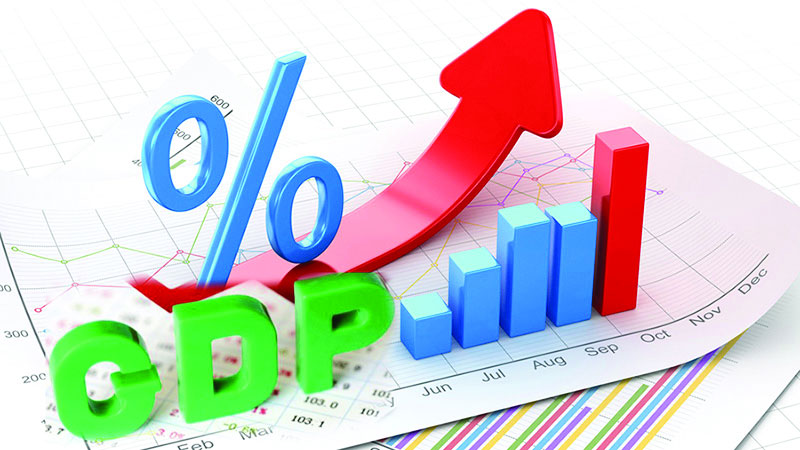Govt struggles to lift tax-GDP ratio to double digits
Staff Correspondent: The government has projected to improve the ratio of revenue to GDP to 10.6 percent in the mid-term (by 2024-25 fiscal), even though the revenue sectors are suffering a lot due to the COVID-19 pandemic and Russia-Ukraine War.
The ratio of revenue to GDP expresses total government revenue as a percentage of gross domestic product. The vast majority of government revenue comes in the form of tax collection. Consequently it is also sometimes known as the tax-GDP ratio.
Other smaller revenue streams include things like bonded warehouses, a customs-controlled warehouse for the retention of imported goods until the duty owed on them is paid.
According to an official document, the revenue-GDP ratio for the running 2022-23 fiscal has been estimated at 9.7 percent, rising to 10.4 percent in the 2023-24 fiscal.
It said that in preparing fiscal policy, the government has been maintaining an expansionary fiscal stance by keeping the budget deficit at a moderate level. Moreover, the government has taken up many reform initiatives to improve the revenue-GDP ratio which is low compared to the neighbouring countries.
Due to the rebasing of GDP to the 2015-16 fiscal, the ratio has dropped even further. Although revenue-GDP ratio has been growing slowly due to high GDP growth, revenue growth has been on a positive trend.
The official document of the Finance Ministry said that several reform initiatives have been taken by the government to reinforce domestic resource mobilisation as well as to improve the revenue-GDP ratio.
It is envisaged that positive impacts of ongoing and future reforms will ensure significantly higher revenue and hence, total revenue is projected to grow to 10.6 percent of GDP in the fiscal 2024-25.
In south Asia Bangladesh has the lowest tax-GDP ratio. A 2016 World Bank report said that the South Asian tax -GDP ratio is 19.1 percent in Nepal, 16 percent in Bhutan, 12 percent in India, 9.9 percent in Afghanistan, 9.1 percent in the Maldive while in Bangladesh it is 8.8 percent. In 2017 Bangladesh’s position in tax-GDP ratio slid to 7.6.
According to available data from World Economic Outlook of October 2019 issue, the revenue GDP ratio of the country is 9.9 percent on average since 2015-2019 while it is 19.8 percent for India, 23.9 for Nepal, 14.7 for Pakistan, 13.5 for Sri Lanka, 25.6 for developing countries and 35.9 for developed countries.
Due to COVID-19, the revenue collection declined while pressure mounted on the budget as the government made high expenditure to face the adverse impact of the economic situation.
The Russia-Ukraine war just added to the woes for the revenue collection authorities as the economic conditions across the globe are suffering heavily.
The document stated that of the 10.6 percent of the revenue GDP ratio in 2024-25 fiscal 9.0 percent will come from National Board of Revenue (NBR), 0.5 percent will be from non-NBR sources while 1.1 percent will be from non-tax sources.
The target for the revenue GDP ratio for 2023-24 fiscal has been estimated at 10.4 percent where 8.8 percent will be from National Board of Revenue (NBR), 0.5 percent will be from non-NBR sources while 1.1 percent will be from non-tax sources.
In the running 2022-23 fiscal the government is projected to get 8.3 percent from National Board of Revenue (NBR), 0.4 percent from non-NBR sources while 1 percent from non-tax sources.
In the previous 2021-22 fiscal, the government had projected to boost the revenue GDP ratio to 11.3 percent with 9.5 percent from National Board of Revenue (NBR), 0.5 percent from non-NBR source while 1.2 percent from non-tax sources.
But in the revised estimation, it lowered down the ratio to 9.8 percent where 8.3 percent was from the NBR, 0.4 percent was from non-NBR sources and 1.1 percent from non-tax sources.
The COVID-19 pandemic and the Russia-Ukraine war was the main cause of lowering down the ratio.
The document said that the government has taken various reform activities to improve the overall revenue collection.
It mentioned that an automated system has been introduced for VAT and income tax collection along with bonded warehouses.
The document hoped that apart from reforms programmes for modernisation of the tax administration, expansion of the tax net, developments in tax compliance and law amendment, and simplification of the tax system would create significant positive impact on revenue collection in the future.
Rare Israeli airstrike in Beirut kills Hezbollah commander and more than a dozen others
International Desk: Israel launched a rare airstrike that killed a senior Hezbollah milita…








